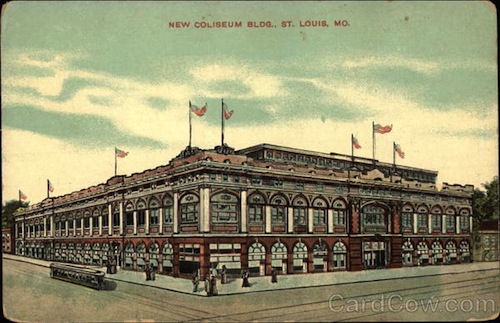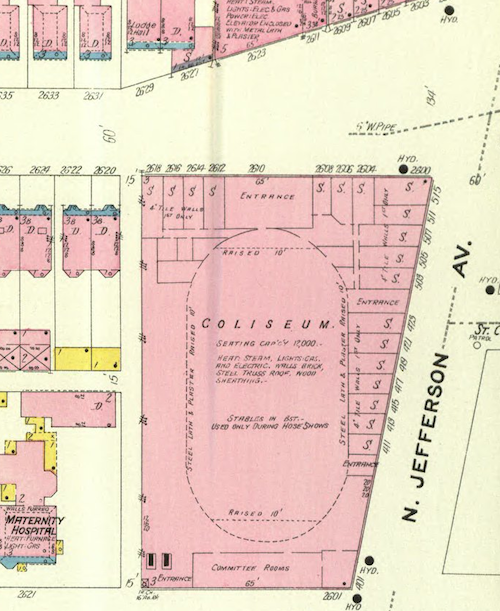St. Louis Hosted The 1916 Democratic Convention
Ninety-six years ago candidates for president were securing delegates to get the nomination for their party. The Democratic Party held their convention in St. Louis:
The 1916 Democratic National Convention was held at the St. Louis Coliseum in St. Louis, Missouri from June 14 – June 16, 1916. It resulted in the nomination of President Woodrow Wilson of New Jersey for President and Thomas R. Marshall of Indiana for Vice-President. (Wikipedia)
St. Louis Coliseum?
The St. Louis Coliseum was an arena in St. Louis, Missouri from 1908 to 1953 at the southwest corner of Washington Boulevard and Jefferson Avenue.
When the cornerstone was laid on August 22, 1908, it was claimed the building would be the largest public building in the United States. It replaced the St. Louis Exposition and Music Hall as the city’s main indoor arena.
The building was leased for several years by Tex Rickard and was the site of boxing matches. It was also a venue for the Veiled Prophet Parade.
Kiel Auditorium which opened in 1934 effectively replaced the Coliseum, and it was condemned as unsafe by the city in 1953. (Wikipedia)
This new Coliseum was needed because the new St. Louis Library was going to be built on the site of the St. Louis Exposition and Music Hall.


Three years after the St. Louis Coliseum was razed Jefferson Bank opened their new facility on the site, see: Jefferson Bank’s 1956 Move South of Delmar, Away From Pruitt-Igoe, & 1963 Protest. View the site today in Google Maps here.
St. Louis built numerous facilities in the early 20th century:
- 1883: St. Louis Exposition and Music Hall, lasted 25 years
- 1908: St. Louis Coliseum
- 1929: St. Louis Arena
- 1934 Kiel Opera House, now Peabody Opera House
- 1977: Cervantes Convention Center, later expanded and now know as America’s Center
St. Louis was a finalist for the 2012 Democratic convention but Charlotte NC was selected.
– Steve Patterson
And your point is? That we have a habit of building new arenas every 20-25 years, or so? That we should continue to do so? That we should have preserved the old structures? That things change? For better? For worse? That we should try, again, to land a national political convention? We were the third-largest city in 1916; today, we’re not even in the top twenty . . . .
Geez, it’s Friday and I’m just sharing some St. Louis history.
Thanks for the bit of history.
I think JZ is just disappointed you haven’t given him anything to analyze to death today which makes it impossible for him to climb up onto his horse.
Rarely is history cited without an agenda, and Steve generally has an agenda. I certainly do appreciate the history lesson, I was just wondering if there was something else that we were supposed to be “learning”?
St. Louis does have a bunch of history, including multiple layers on many lots. And given the recent discussions surrounding the Rams and the Jones Dome, it shouldn’t be a surprise that I’d be making a connection here. Plus, Denver hosted the Democratic national conventions in both 1908 and 2008, so if the same pattern holds here, we should end up hosting the 2016 convention . . . .
We were never the third-largest city. I believe the oft-referenced historical stat of once being the fourth-largest city is even questionable.
Yes we were. But that was the past. I bet the DNC is wishin they picked St. Louis considering how screwed up North Carolina is doing right now…..another democratic opportunity missed.
Typically in screeds about the decline of St. Louis, authors begin with “Once the 4th largest city in the nation..” before going on to document vertiginous population loss. In 1904 and in 1916, the City of St. Louis was ranked by the US Census as fourth in the nation in terms of population. It was at no time ranked third. At that point in its history, city leaders fiercely and routinely contested census results and sometimes won concessions resulting in a higher ranking. This was especially true in the period between the Civil War and the World’s Fair of 1904, when St. Louis was competitive with Chicago in national prominence.This is why I think it possible that the #4 ranking cited then and now is at least questionable.
unless the postcard is embellishing too much, it looks like it was a very beautiful build. Too beautiful for boxing matches, really.
Thanks for the history.